Text & photographs by Dr. Mahadeswara Swamy, Scientist
Mob: 97429-91057; e-mail: [email protected]
Gardening -A Perennial Pleasure
Green Mysuru is a fond dream of many citizens and gardens play a vital role in realising this dream. In the words of Lord Bacon, “Gardening is the purest of human pleasures, the greatest refreshment to the spirit of man.” A few avocations afford so much pleasure as gardening when taken as a hobby or a profession. One of the pleasures of gardening is knowing that each day has something new in store.
Watching a seed or a baby plant grow into a beautiful plant can be a rewarding experience. Just looking at plants gently swaying in the breeze is like a balm to the eye and the soul. The joy one derives from home-grown flowers and vegetables is inexplicable. Nothing is more pleasing than the fragrance of colourful flowers and the soothing green colour of the healthy foliage. Flowers, the soul of the garden are symbolic of beauty, love and tranquillity and convey the message of nature to man. In addition, gardens attract many forms of wildlife (birds, frogs, insects, snails, butterflies etc.) which can add visual beauty to your home. It is a great way to teach children about nature.
Home gardens provide light and pleasant recreation after a day’s hard work and business cares. They make you love your home, be content and satisfied with those pleasures, which neither sting nor pall. There is something always worthy of its care and admiration, some new development of beauty, some fresh design to execute and some new lesson to learn. It is a good feeling to know that you have given something back to nature and are helping the environment.

History
Gardening in India has an ancient history and reference to garden are found in Ramayana and Mahabharata. ‘Ashoka Vana’ in Ramayana and the description of ornamental and fruit trees planted at Indraprastha, the capital of Pandavas as described in Sabhaparva of Mahabharata by Sage Vyasa are examples. Poet Ashvaghosha described the ‘Nandana Vana’ in which Siddhartha saw flowering trees and lotuses. During Buddhist period there were beautiful gardens in Nalanda and Taxila. Gardens were laid out around monasteries and stupas. King Ashok (233 BC) contributed to avenue tree planting. Pleasure garden with beautiful trees and creepers has been mentioned by Kalidasa. Vatsayana (300-400 AD) classified four types of gardens, namely Pramododyana, Udyana, Vrikshavasika and Nandanavana. Art of gardening has been described by Sarangadara (1300 AD) in his ‘Upavana Vinoda.’ Moghal emperors contributed towards introduction of many plants and emperor Babur has presented a description of gardening in India in his book ‘Bagh-i-wafa.’ Europeans brought new vigour to gardens not only by introducing innumerable exotic plants but also establishing many gardens in the country.

Garden
The garden may be defined as an artificial assemblage of plants — an area established with plants with accessories to ornate. It is a valuable and pleasurable adjunct to places we live, work and worship — be it a house, a temple, an office, a factory or a hotel. Manifestation of plants under different environment can result in various kinds of garden. It can be an outdoor garden or an indoor garden; a pleasure garden or utility garden; kitchen garden or flower garden. It can be a window garden, a balcony garden, a wall garden, hanging garden or a terrace garden. It can even be a table garden and miniature landscape (terrariums, bowl and dish garden, bottle garden etc.). A single potted plant in itself is a garden. Garden can also be a park — a large public garden laid mainly for enjoyment of general public. It can be a conservatory, arboretum, botanical garden, water garden, fernery etc.
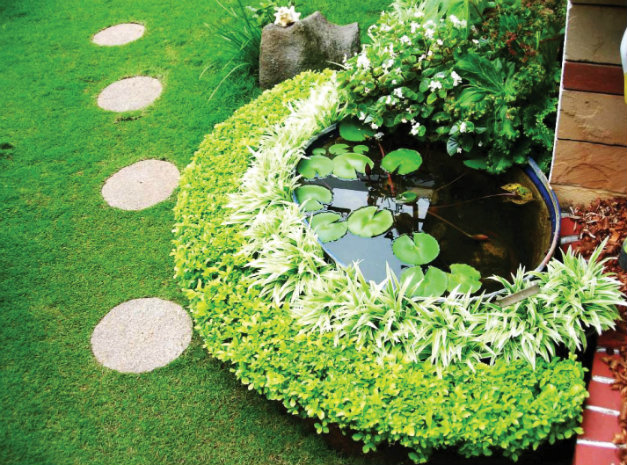
Garden Design
It is the subject of many books, a matter of individual taste depending on features of the layout. It is difficult to lay down any hard and fast rule. However, there are two styles of design, in practice. They are a) Natural and b) Formal — each fancied and admired by its own advocates and opposite in conception.
Natural style, also called “landscape style” aims at an imitation of nature inside the garden to produce a rural effect with large open lawns (uninterrupted) and bordered by clumps of shady trees and shrubs. It is suited for countryside where small dwelling place is situated in a wide expanse of land. It reproduces in a small compass nature’s wild and rugged effect.
Formal or Geometrical style is entirely formal and symmetrical. One half of the garden being the counterpart of the other. Most of the Mughal gardens are formal.
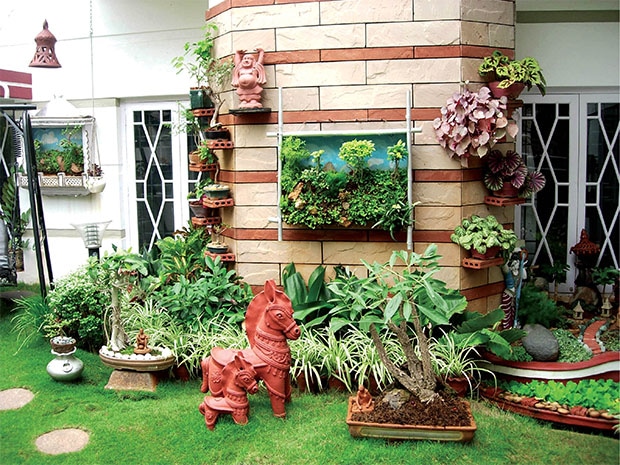
The most favoured style is the free style in urban areas which is also artistic or picturesque and provides more freedom in treatment while taking into consideration the essential typical natural gardens. It is a hybrid style and combines good points of both formal and natural styles.
Considering many variations of style that provide potential for creating a unique design, the personal taste may be the main deciding factor. Nevertheless, there are a few basic principles of design that are best observed irrespective of the style.
a) Balance and harmony are very important. Try to include features which complement each other.
b) Scale and proportions should be considered though difficult.
c) To relate the plants to each other and to adjacent features such as walls and paths.
d) Vistas or focal points may also help to give more substance and definition.
One should also keep in mind the two objectives of garden design:
i) To achieve a natural effect by avoiding the use of too many straight lines;
ii) To keep
To achieve these, one must have the right ingredients in right proportion and mix them in a proper way. The ingredients of an outdoor garden are lawns, walks and paths, herbaceous borders, flowerbeds, trees and shrubs, climbers and creepers overarches, pergolas etc. Accessories to embellish the garden are fountains spilling sparkling water, carved stepping stones, benches, birdbaths and mosaic encrusted urns — just a few of the temptations. Keep in mind that a simple path, lush greenery and gentle landscapes can turn the brief journey from your front yard to your back yard into a breath- taking nature walk.

Bioaesthetic Planning
The main objective of bioaesthetic planning is to beautify the city roads, parks, public places and even compound wall of the houses using appropriate trees and plants. It is a “planned ecology of living beings” from artistic and aesthetic point of view in both towns and villages and goes hand-in-hand with town planning.
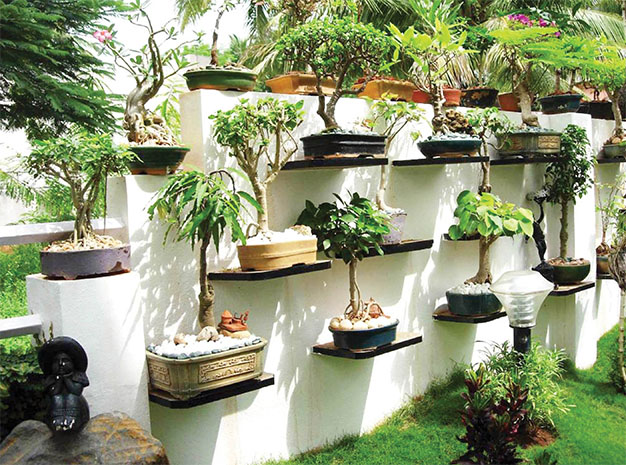
Gardening – An Art or a Science?
A combination of both. It is not only the acquisition of workable knowledge of the science of plants but requires artistic taste. It is the skillful arrangement of plants in a garden making a pattern, a design or a picture. Unless you know the growth habits and the knowledge of raising plants you cannot achieve your aim of planting them at appropriate places, though you are an expert designer or an artist.
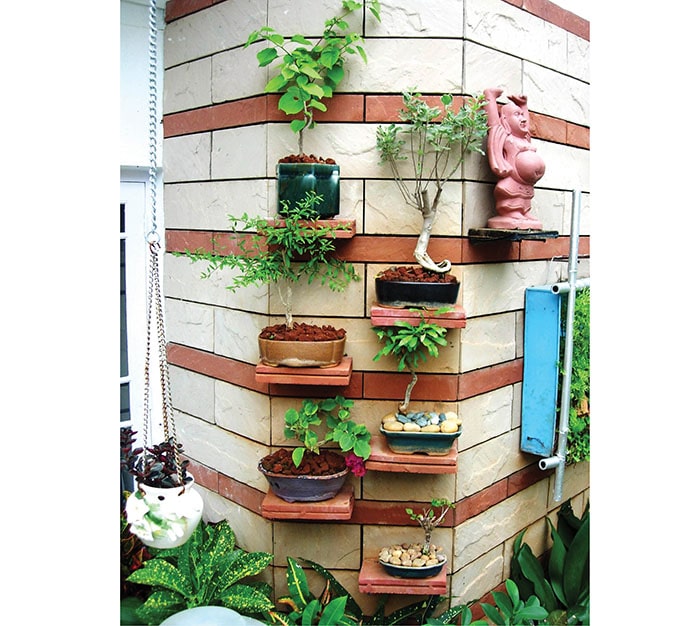
Green Thumb?
It is only a myth. You may wonder why some people excel in gardening. In fact, anybody can become an expert and excel in gardening by learning proper gardening techniques with interest and devotion. Thus, one can make one’s brown thumb green.
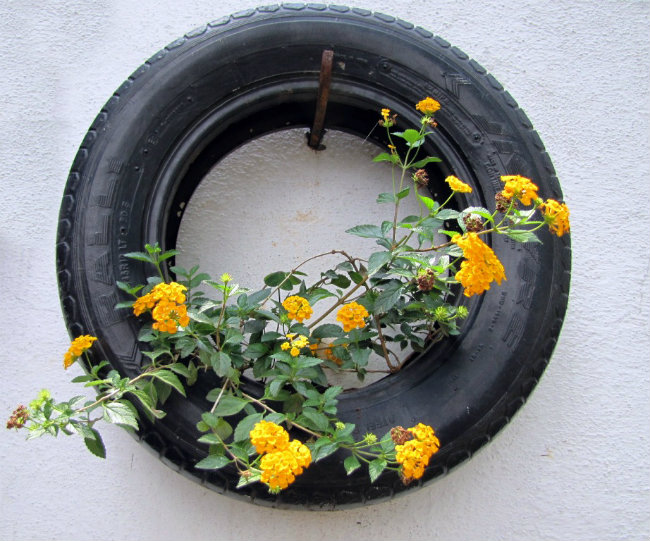
Useful Tips
- One need not have a great deal of space to start a gardening adventure: a small backyard, a balcony or an open space around your place is sufficient.
- Before you venture into gardening decide about your preference whether you need an ornamental garden, vegetable garden or a few
shrubs / trees or a lush green lawn or settle for a few plants in pots. - Before starting, make a frank assessment of the positive and negative aspects of your yard.
- It is very necessary to check the soil and water resources and their quality before starting gardening. If you have weeds in the yard then the soil is fairly healthy.
- Creating or designing a garden in many ways is like decorating the interior of a house. Your main objective is to end up with
practical , pleasurable living space that suits all in your family. - One must think out and evolve a design which would give the maximum of pleasing effect under the prevailing circumstances. With careful planning/
designing even the most barren land can get a new lease of life. Therefore, take note of yourfavourite designing ideas. Think about whether they work for you. Sometimes simplest ideas can makethe big changes. - For landscaping, it is always better to seek the help of a professional to save more money in the long run.
- Remember that the arrangement of plants with their
colourful blooms and foliage in any garden reflects the taste and personality of the creator/ inmates. - In the
beginning one will experience several doubts and difficulties in practical gardening. Exchange ideas with friends/ colleague/neighbours practicing gardening. Consult books on gardening. - Make the entrances look jazz to evoke
interest of passersby — a time-tested theory. It should be the envy of yourneighbours . - If the frontage is facing South or South East, it is always advantageous. The lawns and flowering
annual can be successfully grown. - Plant trees and tall shrubs on the Western and Northern side.
Evening is the best time for watering. Annuals need more water than perennials. Once established, trees and shrubs need watering only a fewdays in a month.- Dig a pit in the “back yard” or in the “work yard enclosure” and put all the dried leaves, weeds, grasses, vegetable waste etc., in a shady area (under a tree) and compost them.
- Go organic and try to use organic manure and bio-pesticides as far as possible.
- Nothing is
more dull than an unattended garden with dried up vegetation, overgrown with weeds. It reflects the negligent attitude of the master. - For successful gardening, there are two golden rules:
- Perseverance: Do not be disheartened if your efforts are a failure in the beginning. Keep a record of what you do and note where you make mistakes.
- Personal attention: Success comes with
personal touch. Remember the old saying “Master’s foot is the best dung.” Few malis work well unlessthey are maderealise that master is taking a personal interest in the success of their work. - Tailpiece: It is always easier said than done. Applies to me as well.








Recent Comments